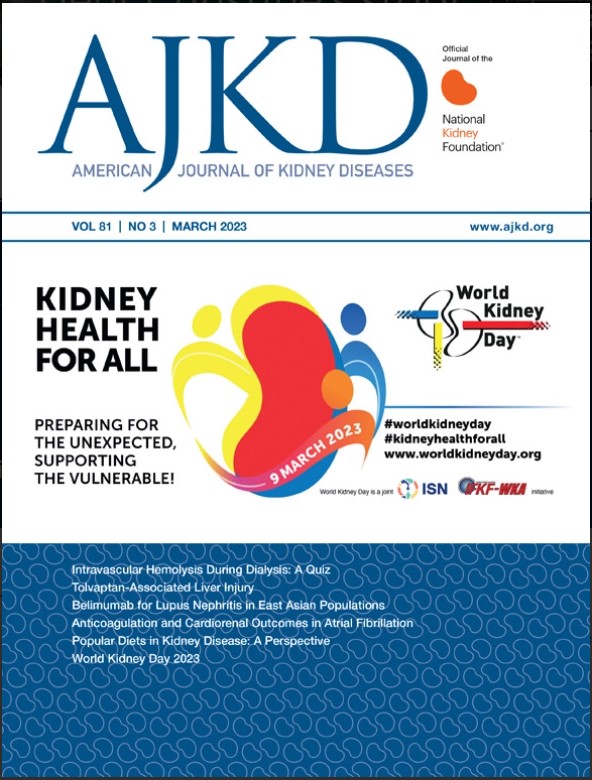血液滤过与高通量血液透析的死亡率比较:一项巴西队列研究。
IF 8.2
1区 医学
Q1 UROLOGY & NEPHROLOGY
引用次数: 0
摘要
理由与目的:血液滤过(HDF)与高通量血液透析(HD)相比具有更好的生存率,但这些研究主要在发达国家进行。这项研究检查了巴西肾衰竭患者的死亡率风险,比较了HDF治疗和高通量HD治疗。研究设计:观察性队列研究。环境和参与者:2022年1月1日至2023年12月31日,在巴西29家透析机构接受维持性透析(高通量HD和HDF)的所有成年患者。暴露:HDF患者与高通量HD患者的治疗。结果:心脑血管和感染相关疾病的全因死亡率和病因特异性死亡率。分析方法:多变量Cox比例风险回归,其中透析方式被认为是时间更新的暴露。结果:8391例患者纳入研究:6787例患者仅接受高通量HD, 2836例患者接受HDF,其中1222例患者在随访期间从高通量HD转移到HDF。两组2年生存率分别为81.2%和77.9% (p < 0.001)。接受HDF治疗的患者与接受HD治疗的患者相比,调整后死亡风险显著降低(HR 0.73;95%可信区间[CI], 0.63-0.85)。HDF治疗也与心血管死亡风险的降低有关,但与感染相关死亡无关。在亚组分析中,与HDF相关的死亡风险降低在各亚组中是一致的,在65岁以下的患者中观察到更明显的效果(HR, 0.56;95% CI, 0.42-0.77)大于65岁或65岁以上(HR, 0.82;95% ci, 0.70-0.96)。在一项敏感性分析中,仅将HD和HDF作为起始治疗,并在透析方式改变时删除数据,HDF治疗与较低的死亡风险相关(HR 0.73;95% ci, 0.62-0.85)。局限性:回顾性设计和相对较小的随访期。结论:在巴西进行的这项大型队列研究中,与传统的高通量HD患者相比,接受HDF治疗的患者表现出更低的全因死亡率和心血管死亡率。本文章由计算机程序翻译,如有差异,请以英文原文为准。
Mortality on Hemodiafiltration Compared to High-Flux Hemodialysis: A Brazilian Cohort Study
Rationale & Objective
Hemodiafiltration (HDF) has been associated with better survival than high-flux hemodialysis (HD), but these studies were mainly conducted in developed countries. This study examined the mortality risk among Brazilian patients with kidney failure, comparing treatment with HDF to treatment with high-flux HD.
Study Design
Observational cohort study.
Setting & Participants
All adult patients on maintenance dialysis (high-flux HD and HDF) at 29 dialysis facilities in Brazil between January 1, 2022 and December 31, 2023.
Exposure
Treatment with HDF patients versus high-flux HD.
Outcome
All-cause mortality and cause-specific mortality attributed to cardiovascular/cerebrovascular and infection-related diseases.
Analytical Approach
Multivariable Cox proportional hazards regression in which dialysis modality was considered a time-updated exposure.
Results
The study included 8,391 patients: 6,787 receiving only high-flux HD, 2,836 receiving HDF, among whom 1,222 had migrated from high-flux HD to HDF during the follow-up period. The 2-year survival rates in these groups were 81.2% and 77.9%, respectively (P < 0.001). A significantly lower adjusted death risk was observed among patients receiving HDF versus HD (HR, 0.73 [95% CI, 0.63-0.85]) in a time-updated analysis. HDF treatment was also associated with a reduction in cardiovascular mortality risk but not in infection-related death. In the subgroup analysis, the reduction in mortality risk associated with HDF was consistent across subgroups, with a more pronounced effect observed in patients under the age of 65 (HR, 0.56 [95% CI, 0.42-0.77]) than for those aged 65 or more (HR, 0.82 [95% CI, 0.70-0.96]). In a sensitivity analysis including only HD and HDF as starting therapy and data censored at the time of dialysis modality change, treatment with HDF was associated with a lower death risk (HR 0.73 [95% CI, 0.62-0.85]).
Limitations
The retrospective design and a relatively small follow-up period.
Conclusions
In this large cohort study conducted in Brazil, patients treated with HDF, compared with those treated with conventional high-flux HD, exhibited a lower risk of all-cause and cardiovascular mortality.
Plain-Language Summary
Hemodialysis (HD), after decades of dominance, has been challenged by online hemodiafiltration (HDF) as the new standard of therapy for kidney failure. HDF has been associated with better survival in recent clinical trials. However, data are scanty about its benefits in real-world studies with unselected dialysis populations. In this retrospective cohort study, we compared the mortality risk in patients treated with HDF (n = 2,826) to the risk among those treated with high-flux HD (n = 6,787) in Brazil. The 2-year survival rates in these groups were 81.2% and 77.9%, respectively (P < 0.001). The adjusted all-cause mortality risk was 27% lower for patients treated with HDF compared with HD. HDF treatment was also associated with a 34% reduction in cardiovascular mortality risk.
求助全文
通过发布文献求助,成功后即可免费获取论文全文。
去求助
来源期刊

American Journal of Kidney Diseases
医学-泌尿学与肾脏学
CiteScore
20.40
自引率
2.30%
发文量
732
审稿时长
3-8 weeks
期刊介绍:
The American Journal of Kidney Diseases (AJKD), the National Kidney Foundation's official journal, is globally recognized for its leadership in clinical nephrology content. Monthly, AJKD publishes original investigations on kidney diseases, hypertension, dialysis therapies, and kidney transplantation. Rigorous peer-review, statistical scrutiny, and a structured format characterize the publication process. Each issue includes case reports unveiling new diseases and potential therapeutic strategies.
 求助内容:
求助内容: 应助结果提醒方式:
应助结果提醒方式:


